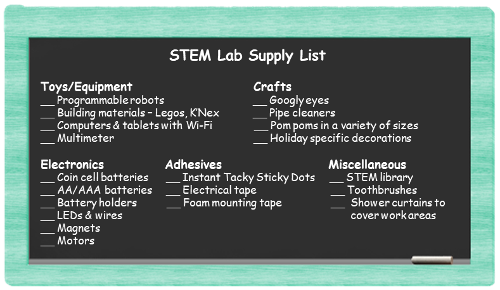

Science, Technology, Engineering, and Math – or STEM – is an interdisciplinary approach used to help kids become critical thinkers and problem solvers. It’s a project-based way to teach these subjects together, as your kids explore real-world problems. This approach should include collaborative, and hands-on opportunities for your kids to use technology and an engineering design process to apply their math and science knowledge.
Help your kids collaborate with others to design and build a robot that can maneuver around rubble to locate earthquake survivors. Or help them work through an engineering design process as they develop plans for a living environment that can be used on the moon. Just remember that whatever projects you’re interested in, they don’t have to use all four subject areas. You may find some of your ideas only require two or three of them.
Our goal this month is to help you create a STEM lab where your kids can go to work on a specific project or to just create. Think of it as their own mini Makerspace.

Before you make any purchases for your new STEM lab, you should sit down and examine your specific situation. Take the time to plan so creating your new lab will be more efficient and cost-effective.
LOCATION
First, you need to determine the best location for your new space. You want this space to be comfortable and have it appeal to your kids. If possible, you may want this spot to be large enough for your kids to have room to build and test their projects.
Collaboration with other kids, when possible, is an important aspect of STEM activities. A location that can be flexible enough in size to include friends, siblings, or fellow students is another key feature to consider.
Parents:
Are you looking at a permanent spot that you can make welcoming at any time, or would you prefer something more portable that you can use at the kitchen table when you’re ready to start a project?
Teachers:
Will you be setting up a STEM lab within your classroom for just your students, or has your school administration designated a room for the lab and asked you to create this spot for the whole school?
REQUIREMENTS
No two STEM lab setups will be the same. There will undoubtedly be similarities from lab to lab, but you need to ask yourself what type of STEM activities you’re hoping to offer and what age kids will be delving into these activities.
If your STEM lab will include robots – and we really hope you include robots – you may prefer a location that allows your kids the needed room for maneuverability, as well as Wi-Fi access.
A STEM lab that is meant to be used by different aged kids should be designed with safety in mind. Our homopolar motor investigation, The Spinning Copper Contraption Mystery, uses neodymium magnets to rotate a copper contraption around a AA battery. These rare earth magnets should always be kept out of reach of younger kids, or kids who tend to put things in their mouth. A designated drawer or cupboard that can be locked may be an essential requirement for some labs.
Parents:
If your goal is to create a space where your kids can come and go as they please, include a STEM notebook full of project ideas and instructions. This will help make your lab more user-friendly. You may even want to sit down with your kids for their input.
Teachers:
The number of kids you need to create your space for will be an important factor as you determine the number of supplies needed, how these supplies will be stored, and what activities you hope to engage your students in.
You may also need to sit down with your administration to allow them input into which activities you want to offer in this new space.
SUPPLIES
Think about your supply needs categorically. You will want to compose checklists for:
• project-specific items;
• decorative items that can be used to personalize finished projects;
• miscellaneous building materials;
• equipment;
• storage;
• furniture.
Note: A well-stocked space should be organized and include items that cover all aspects of STEM education.
FUNDS
You have a location for your STEM lab. You have a general idea of the type of activities you want your kids to work on, and you compiled your supply checklists. It’s time for the hard part – you have to decide what you can and cannot afford right now.
Note:
The more supplies you can buy in bulk, the more money you will save in the long run.
Parents:
The less you spend on furniture, the more you can spend on supplies and equipment. It wouldn’t hurt to check out:
• Second-hand shops;
• State surplus supply stores;
• College surplus property sales.
Teachers:
As a teacher, you know that money will be tight, but there are options out there. Every donation you can get will leave the funds you do have for the more expensive items on your checklists. Some additional options are:
• Send home a wish list with your students;
• See if the PTA will ask for donations of money and/or supplies at their next meeting;
• Look into web-based non-profit donation sites for teachers – for example, DonorsChoose.org.
Good Luck!
We hope this information will help you with your endeavor to create a STEM lab your kids will love to use.
